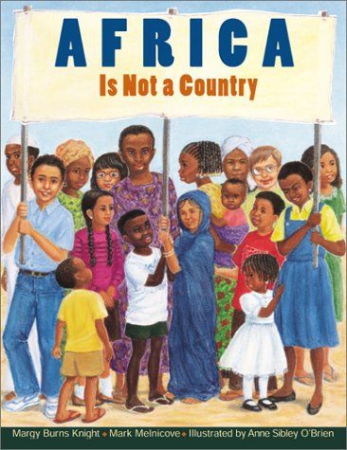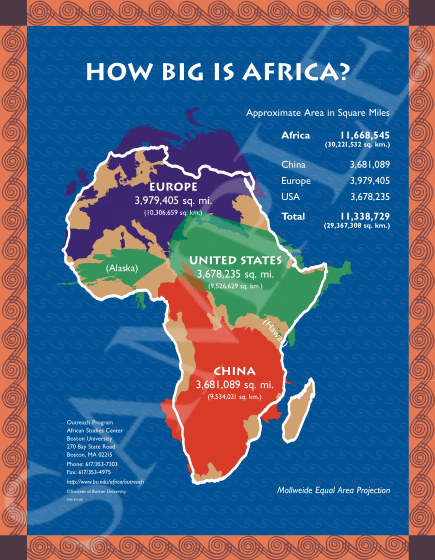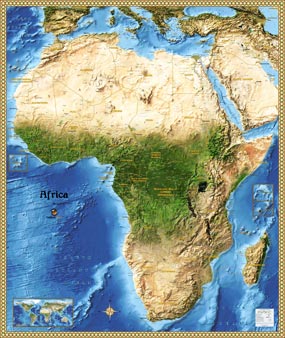- What is Africa?
- Where is Africa?
- What do we know about Africa?
- African Diversity
- African Art: African Influences in Modern Art
- African Masks: Ceremonies, Costumes, Animal Masks, Dance & Music
- African Mask Project
- Mask Closing Ceremony
- Class Gallery
- What is Africa?
- Can you find Africa on the world map?
- What do we know about Africa?
- the world’s second-largest continent
- the second-most-populous continent
- the only continent with land in all four hemispheres
- nearly as long as it is wide
- has the largest (nonpolar) desert in the world, Sahara
- has the longest river in the world, the Nile
- The Serengeti ecosystem in northern Tanzania and Kenya hosts the largest terrestrial mammal migration in the world
- Okavango Delta in Botswana is one of the world’s largest inland delta
- Namib desert is the oldest and has the highest sand dunes in the world
- has 54 independent countries
- more than 1,000 different ethnic groups
- is speaking some 1,600 languages, more than any other continent
- is considered the birthplace of humans
- Lucy, the 3.2-million-year-old fossil was the first Australopithecus afarensis skeleton ever found in Hadar, Ethiopia
- Just recently scientists have discovered a new species of human ancestor (Homo naledi) deep in a South African cave, adding a baffling new branch to the family tree.
- African Diversity
- Sahara in the north
- Central rain forests and tropical grasslands
- More dry land to the south.
- Some are familiar, such as giraffes, monkeys and rhinoceros.
- Others are only to be found here, like on the isolated island of Madagascar (lemurs)
- Yet others are rare or under threat of extinction, like the African elephant, lion, penguin or cheetah.
- African Art
- the basic shape of the object is square, rectangular, round, oval, triangular…
- the object is: symmetrical, asymmetrical, simple, complex…
- it seems to be made mainly of: wood, metal, stone, clay, fabric, shell…
- the surface is mainly: shiny, dull, smooth, rough, plain, fancy, painted, carved…
- title, country, ethnic group
- what I personally like most about the object and why, and/or my thoughts about it
- African art is characterized by stylization (ideas, patterns, designs rather than real appearance)
- African art is different from much of the art you will find in a museum because African art objects were not created to be in a museum!
- Traditional African art is functional, it is made to be used, touched, talked to, danced with, slept with, sat upon, fed, worn…
- African Masks
- Masks are usually considered the “heads of spirits”.
- Masked characters can be nature spirits or revered ancestors.
- Supernatural beings are believed to control most human activities and should be honored in appropriate masking ceremonies.
- A masking ceremony is called a masquerade and the person who wears the mask and the costume a masker.
- Although masks can depict both males and females, maskers are usually men.
- Just as there are many different ethnic groups in Africa there are also many types of masks and masking ceremonies.
- The costume of a masker is as important as his wooden mask.
- The costume covers all of the masker’s body because the identity of the masker is meant to be hidden from audience.
- During the masquerade, the masker is no longer himself, he is transformed in the spirit of the mask.
- The world of African spirit masks is rich with images of animals and insects.
- Some animals appear in complex legends about human activities, like the antelope that introduced farming to the Bamana people of Mali
- Animal masks never copy a specific animal, they rather use animal features as symbols, like exaggerated horns and teeth as attributes of power.
- Music and dance are also central to a masquerade.
- Certain masquerades are conducted only at night under the dramatic lighting of fires or torches.
- There are many different elements to a masquerade: the mask, the costume, the masker’s movements, his words, the music, audience participation, lighting, spiritual beliefs…
- African Mask Project: Create a mask that will transform you!
- If you could have one special power what would it be?
- What powers did your mask get from an animal?
- What visual characteristics could symbolize that power?
- What do your colors on the mask mean?
- What is your mask called?
- Mask Closing Ceremony
- Class Gallery
The places pictured inside the map of Africa include a continent, two countries, and two states. Which are which?
From space, Africa appears divided into 3 regions:
Africa is home to many different animals.
Within such a large land and diversity of nature, animals, people and history it’s no wonder that art is everywhere in Africa.
From prehistoric rock art, ancient Egyptian pyramids, African art had evolved to all aspects of daily life: pottery and baskets for cooking, textiles and jewelry for decoration, sculptures and masks for special rituals and ceremonies.
Let’s look at some African art objects.
What do you see when you really look?
What did you notice about the African art?
African Influences in Modern Art
From stories you read or other cultural experiences, in what kind of ceremonies do you think these masks could be used?
Examples: rites for planting, harvesting, prosperity, good health, rites of passage. birth, coming of age, marriage, initiations, funerals, ancestral commemoration, visits of high-status people…
Can you guess what animals these masks represent?









Bring rain, good harvest, shift shapes…
Use African animal features (teeth, horns, spots, stripes, mane) to represent your power!
Make your mask abstract by using techniques of simplification, exaggeration and elongation.
Geometric patterns refer to moral principles, like the zigzag lines that signify the “path of the ancestors”.
The checkerboard pattern signifies the process of learning childhood (white) to elderhood (black).
Owl eyes or big forehead mean wisdom.
For example, the colors available can have the following meaning: red for joy, black for earth, white for purity.
If using other meanings, make a legend or map for your symbols!
You can even write a story about the mask you created!
Here are some African designs for inspirations!























































